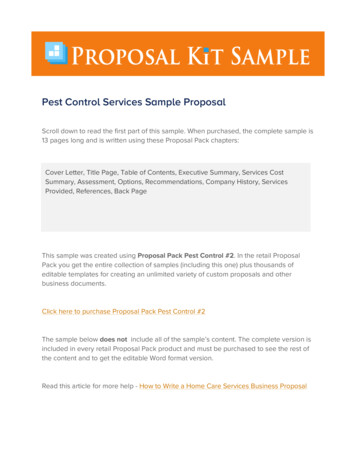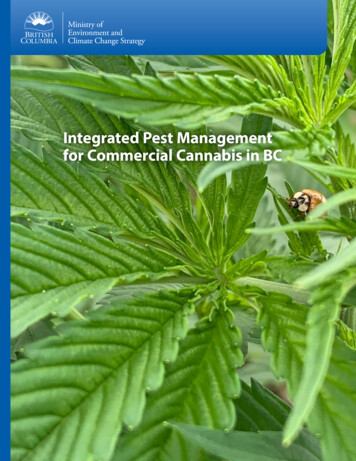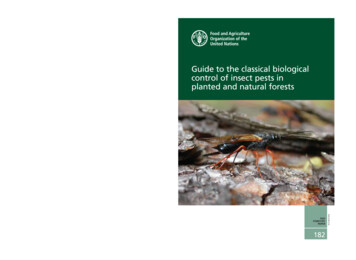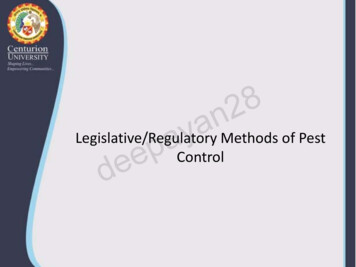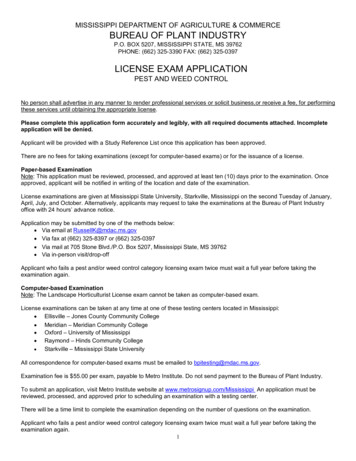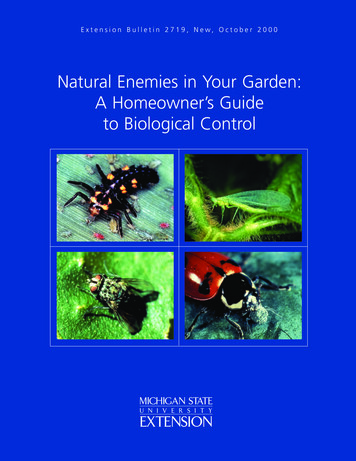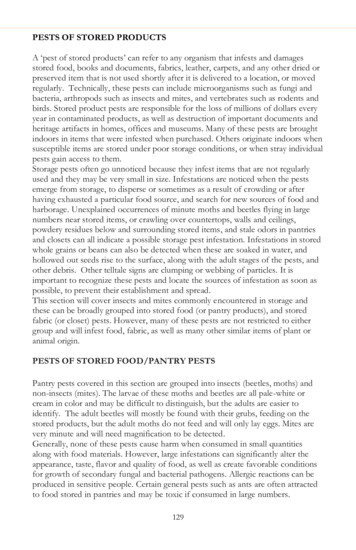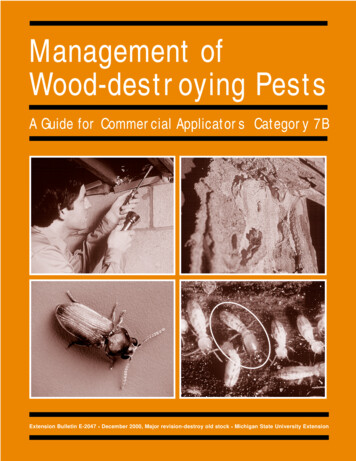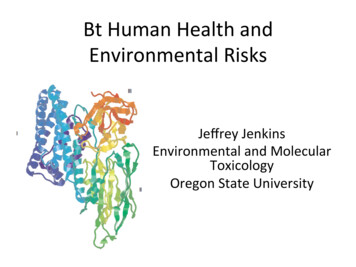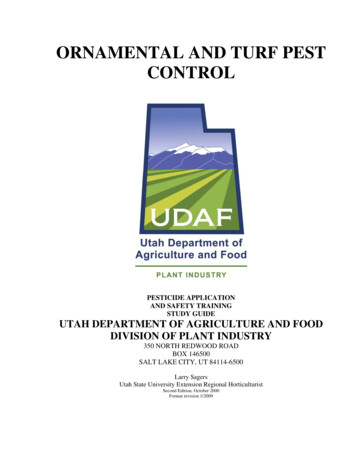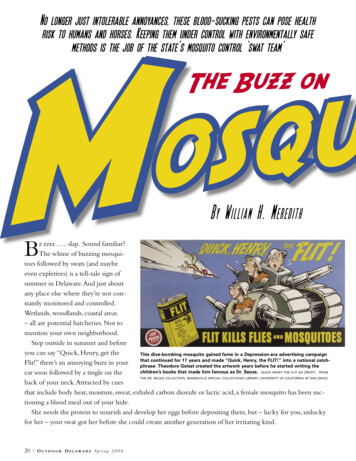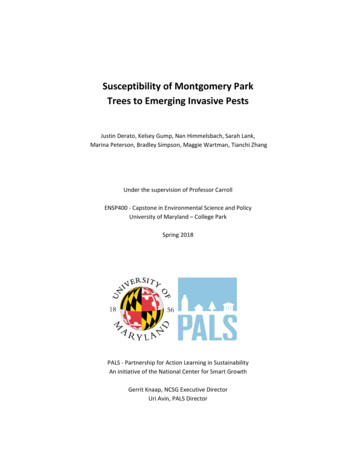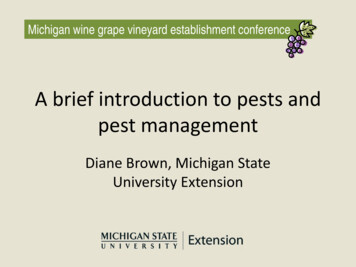
Transcription
Michigan wine grape vineyard establishment conferenceA brief introduction to pests andpest managementDiane Brown, Michigan StateUniversity Extension
What is a pest? Any organism that isdetrimental to humans– destroys crops & structures– poses threats to human healthand livestock– reduces aesthetic andrecreational value2
Main categories of pestsinsects and mites- Invertebrates (no backbone)
Several common insect pests of grapes Grape berry moth Potato leafhoppers Japanese beetle
Main categories of pests diseases- caused by Pathogens – living agents– Fungi– Bacteria– Viruses– Nematodes– Phytoplasmas Disorders-Non-living agents:– cold, heat, pollutants, chemical injury
Main categories of pests Vertebrates (with a backbone)– Birds– Deer– Raccoonsnetting to reduce bird damage
Main categories of pests Weeds – “unwanted plants”GrassesBroadleafPerennialAnnual/ biennial
How to manage? Integrated Pest Management (IPM) Uses multiple strategies to manage pests andpest damage Examples will be given later
Steps in IPM Identify the pest and know its biology Monitor and survey for pests Set IPM goal: prevent, suppress Implement-select control strategies, timing, Economics Environmental impacts Evaluate
Steps in pest management is it really a pest or: Just there? A beneficial insect?Texas Forest Service Archive, Texas Forest Service, Bugwood.orgGerald J. Lenhard, Louisiana State University, Bugwood.org
Steps in pest management Identify the pest and pest damage- critical Learn key pestsIdentify lifecycle stagesOverwintering stageStages causing damageStages that can be controlled
examples Japanese beetle Adult is damaging stage on grapes Larvae feed undergroundon roots of grasses
examples Black rot is a fungus Overwinters on mummified fruit Spores produced in mummies lands onleaves Spores produced on leaves land on fruit
Pest Identification is Critical Use books, extensionbulletins, field guides,Web, etc. Have pests examinedby specialists– Handle samples carefully
Steps in IPM Identify the pest and know its biology Monitor and survey for pests Set IPM goal: prevent, suppress Implement-select control strategies, timing,Economics Environmental impacts Evaluate
Steps in pest managementMonitoring when is the pest likely to appear? May be tied to particular stage of plantdevelopment May be related to weather or environment
Monitor the Pest Use scouting, trapping, weather data, models Enviroweather websitehttp://www.enviroweather.msu.edu/
Steps in IPM Identify the pest and know its biology Monitor and survey for pests Set IPM goal: prevent, suppress Implement-select control strategies, timing Economics Environmental impacts Evaluate
What is your goal for integratedpest management? Prevent Suppress
Components of IPM-Monitor the Pest Action threshold: unacceptable pest level –do something Sometimes the action threshold may bezero! Action thresholds vary by pest, site, andseason
Pest Population Economic Threshold- controlneeded to prevent economicinjury Economic Injury Level– of losses of control measures– Apply control measure priorto reaching economic injurylevel0Time
Develop the IPM Goal Prevention: examples, resistant plants,sanitation, exclusion, pesticide treatments Suppression reduction: cultivation, biologicalcontrol, pesticides
Steps in IPM Identify the pest and know its biology Monitor and survey for pests Set IPM goal: prevent, suppress Implement– Select control strategies– Timing Economics Environmental impacts Evaluate
Implement the IPM Program Make sure you have taken initial steps– Identification and monitoring– Set action thresholds– Know what control strategies will work Select effective and least harmful methods
pest management tactics Mechanical: Cultivation Disrupt soil conditions for weeds and insects– Hoes, Plows, Disks Control growth or destroy plants– Mowers
Mechanical: Trapping Use of mechanical or sticky device Captures pests in a holding device Restrains or kills the pest
Mechanical: Exclusion Netting to exclude birds Fencing to keep out deer
Physical controls- alter the environmentExamples for black rot Open canopies to reduce humidity and leafwetness Plant rows in direction of prevailing winds
Cultural control: sanitation Sanitation: eliminate food, water, and shelter destroy infected crop residues or infectedplant materials Destroy weeds to reduce pest refuges
Cultural controls- alterconditions or pest behavior Examples for black rotPlant resistant or less susceptible varietiesPrune out dead canes and mummiesRemove fruit mummies from the ground
Biological controls Natural enemies Any organism that reducesthe numbers of another.Texas Forest Service Archive, Texas Forest Service, Bugwood.orgLacewing larva
Biological Control in the vineyard Conservation and EnhancementManipulating habitat and resources toconserve or enhance NE numbers. Augmentation-Releasing NE’s to boostpopulation.
Predators and Parasitoids PredatorsMainly insectsKill and consume prey ParasitoidsLive in/on hostKill hostRuss Ottens, Universityof Georgia, bugwood.orgWinston Beck, Iowa StateUniversity, bugwood.org
Pathogens Bacteria, fungi, protozoa, nematodes andviruses- naturally occurring or commercial B.t.- Bacillus thuriengensis, a biologicalinsecticide used to kill moth larvae Grandevo, a microbial insecticide Beauvaria bassiana (fungus)- Naturalis,Botanigard
Summary Biological Control can be effective.BUT-Requires careful planning and knowledge.MONITORING!Integrating pest management methods toreduce chemical use and conserve naturalenemies.
Chemical controls Pesticide any material thatis applied to kill,attract, repel, orregulate pests
Considerations for Pesticide Use Identify the pest and selectthe appropriate product Avoid developing resistantpest populations If using pesticides, use thecorrect application rate andtiming
Pesticide Classification General Use– normally lower toxicity– no special certification or permits required Restricted Use (RUP):– may cause adverse effects to human health or theenvironment– sold only to certified applicators
“The label is the law” The site must be stated on the label The target pest does not need to be listed Any application method may be used, unlessprohibited by the label
“The label is the law” Applications may be made at a rate less thanthat stated on the label, not more! Tank mixtures are OK, unless the label saysotherwise
Pesticide terms Mode of action: how it works to control the pest Systemic pesticides-absorbed through tissues andtransported elsewhere where the pest encounters it Contact pesticides must come in direct contact withthe target pest
Pesticide Resistance:the ability of a pest to tolerate apesticide that once controlled it
Pesticide Resistance:Intensive pesticide use- kills susceptiblepests in a population, leaves resistantones to reproduce
Pesticide Resistance: Use of similar modes of actionFrequency of applicationsPersistence of the chemicalPest rate of reproduction &offspring numbers
Pesticides vary by selectivity Non-selective – kills all related pests – forexample some herbicides kill all green plantsthat gets a sufficient dose Selective – kills only certain weeds, insects,plant pathogens – for example otherherbicides only kill broadleaf weeds notgrasses
Pesticides vary by persistence: how long they remain active in theenvironment Residual pesticides – remain active for weeks,months, years Non-residual – inactivated immediately orwithin a few days
Considerations for integratingchemical and biological control Use selective insecticidesLow residual toxicityBiopesticidesApplication TimingsNatural enemy refuges
IPM in the vineyard Regardless of the methods chosen,remember: Identify the pest and know its biology Monitor and survey for pests Set IPM goal: prevent, suppress
IPM in the vineyard Consider the economics- action thresholds Environmental impacts- what else are youimpacting
Record and Evaluate Results what worked; what did not May take time to see results Might be ineffective ordamaging to target crop,beneficial insects, etc. Use what you learned forfuture pest managementplanning
Mode of action: how it works to control the pest Systemic pesticides-absorbed through tissues and transported elsewhere where the pest encounters it Contact pesticides must come in direct contact with the target pest Pesticide terms . Pesticide Resistance:
